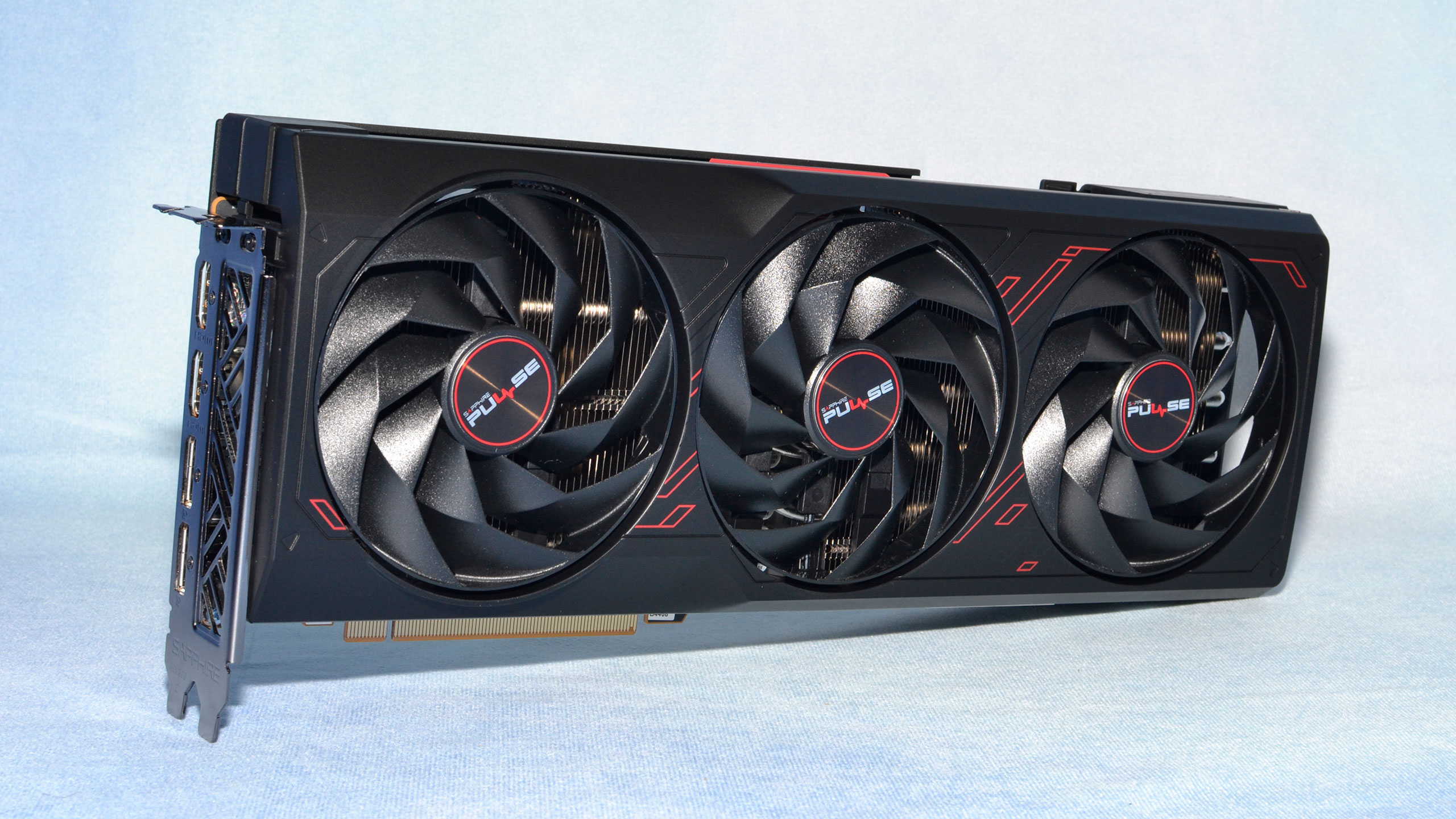Why you can trust Tom's Hardware
GPUs are also used with professional applications, AI training and inferencing, and more. Alongside our professional tests, we've added Stable Diffusion benchmarks on the various GPUs. We're using the Automatic1111 Stable Diffusion project for the Nvidia cards, with TensorRT extensions enabled. Intel has an OpenVINO fork, and AMD has a DirectML fork, both of which are recommended by the respective companies for their GPUs.
AMD RX 7900 GRE AI Performance

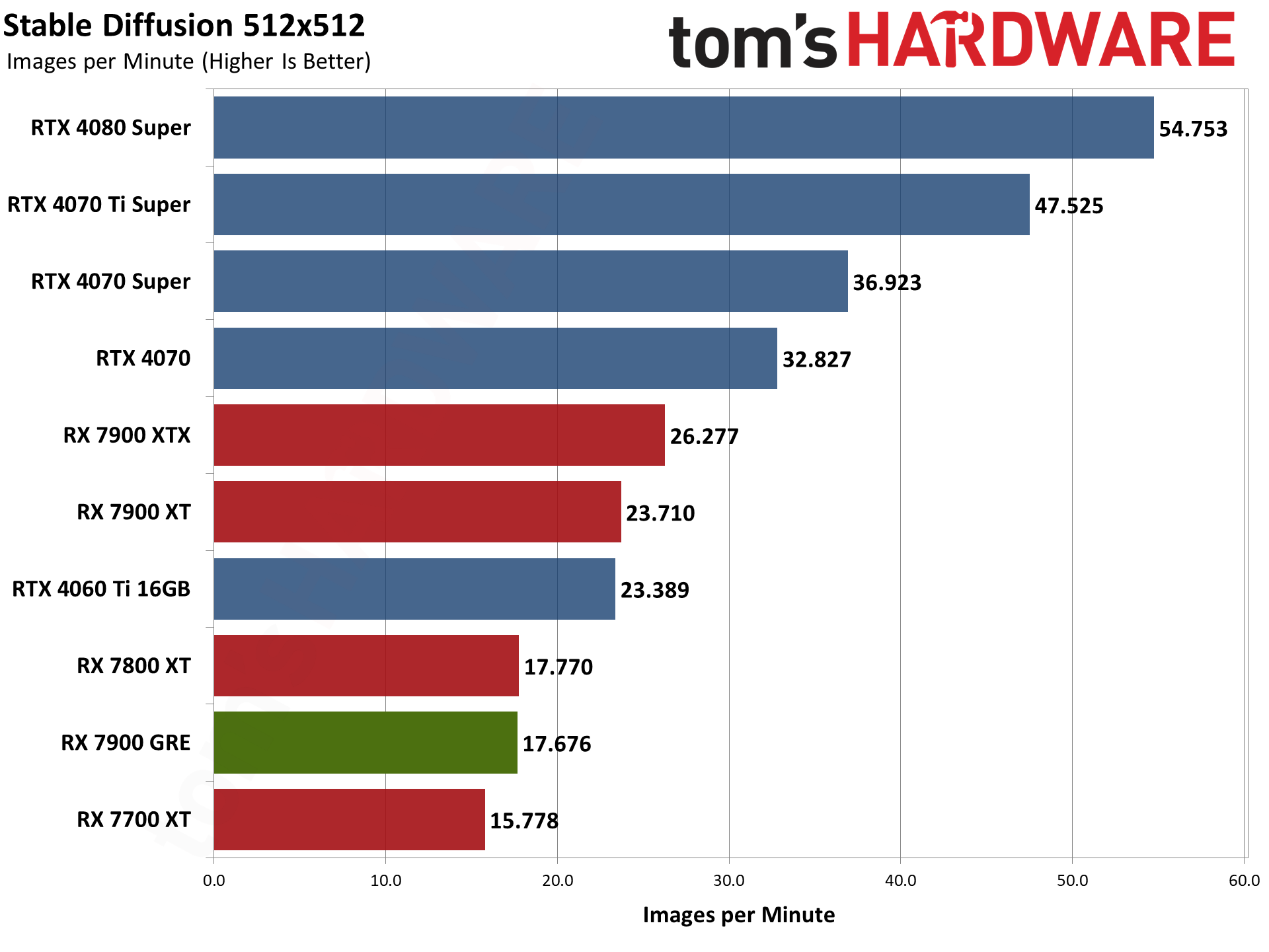
The RX 7900 GRE specs are worth revisiting here, in that it has 8% less memory bandwidth than the 7800 XT but 23% more compute. Most of our gaming benchmarks ended up with the 7900 GRE about 10% faster on average, but in Stable Diffusion at least, it seems memory bandwidth plays a bigger role.
The RX 7900 GRE comes in just slightly behind the 7800 XT at 512x512 image generation, and 4% ahead with 768x768 images. Higher resolutions with Stable Diffusion are often more compute intensive, so that makes sense, but it also shows that there are at least some instances where the normally faster 7900 GRE will fall behind the cheaper card. Notice also that the 7900 XT is 34% faster at 512x512 and 31% faster at 768x768, and it has 39% more bandwidth.
Looking at Nvidia's competing GPUs, their AI prowess shows up in a big way, with the RTX 4070 providing 86% faster 512x512 image generation, and 76% faster 768x768 generation. Even the significantly less expensive RTX 4060 Ti 16GB beats the 7900 GRE by 32% and 16%, respectively, at those same resolutions.
Not only are Nvidia's GPUs substantially faster at AI, but there are far more projects that target Nvidia hardware — not to mention things like the new Chat With RTX app that Nvidia now provides. As with ray tracing games, if you're really interested in AI, we strongly recommend picking an Nvidia GPU right now. The company has a substantial lead over its competitors in this arena, and it could be many years before the gap narrows.
AMD RX 7900 GRE Professional Workloads
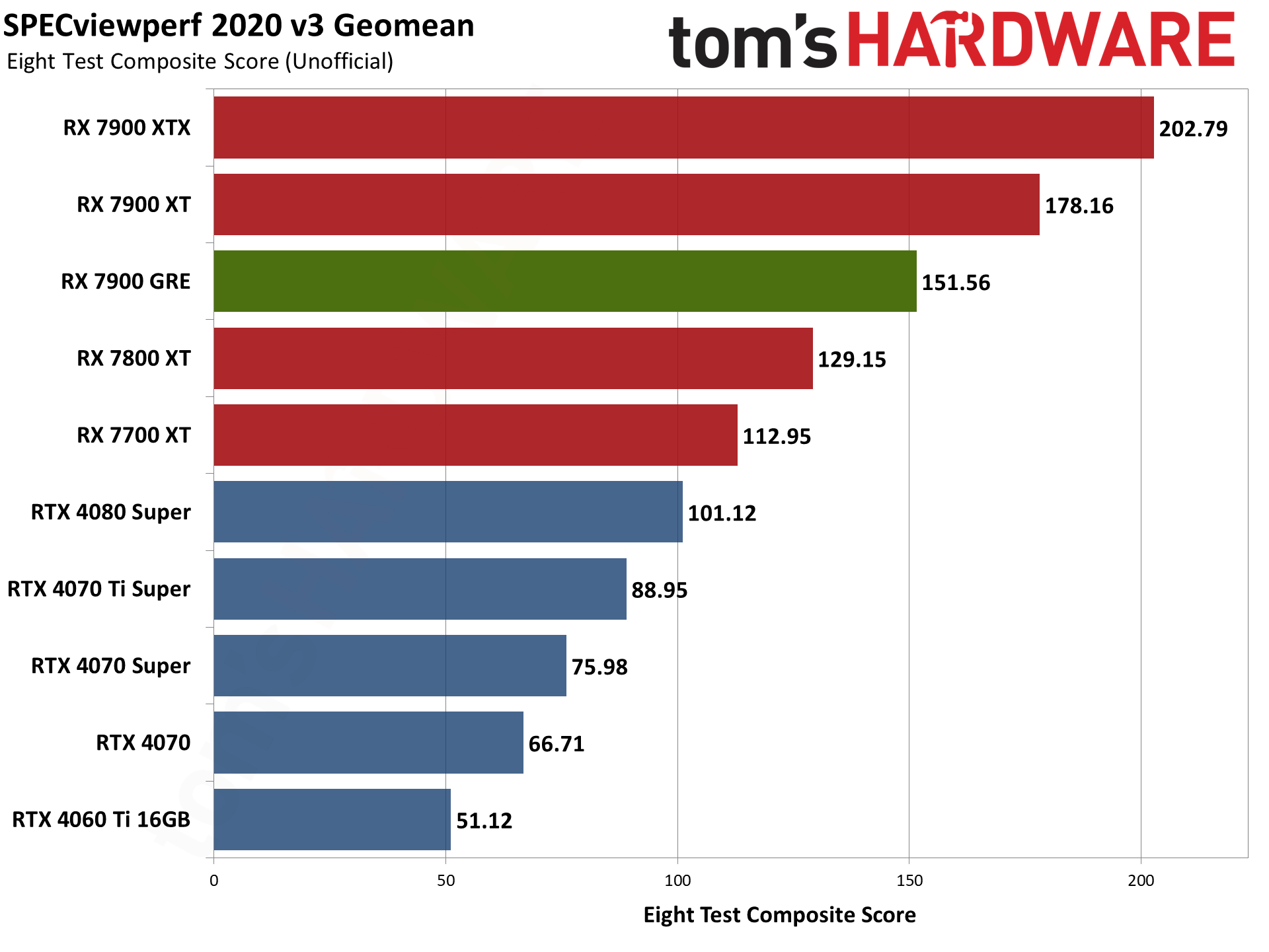

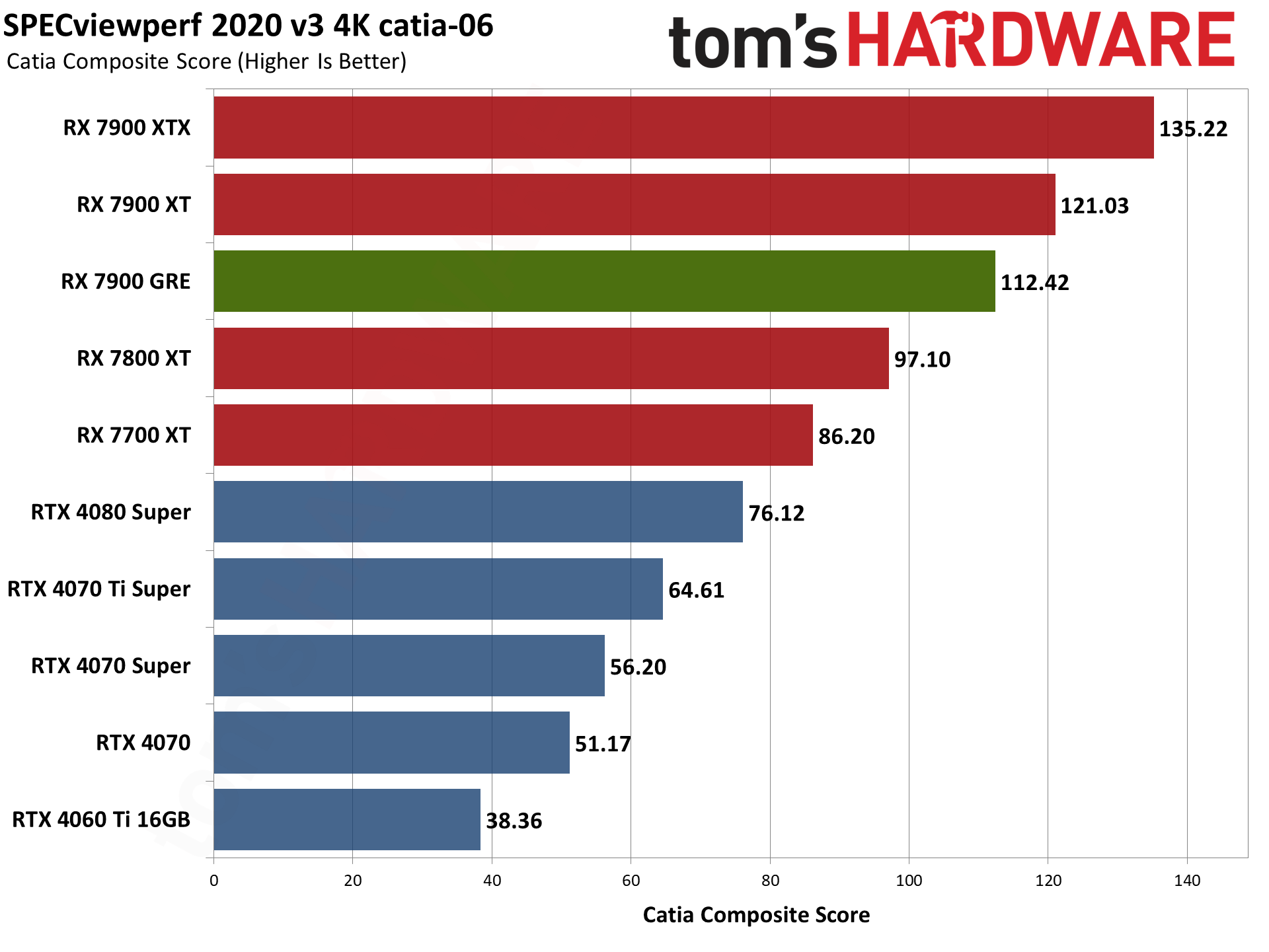
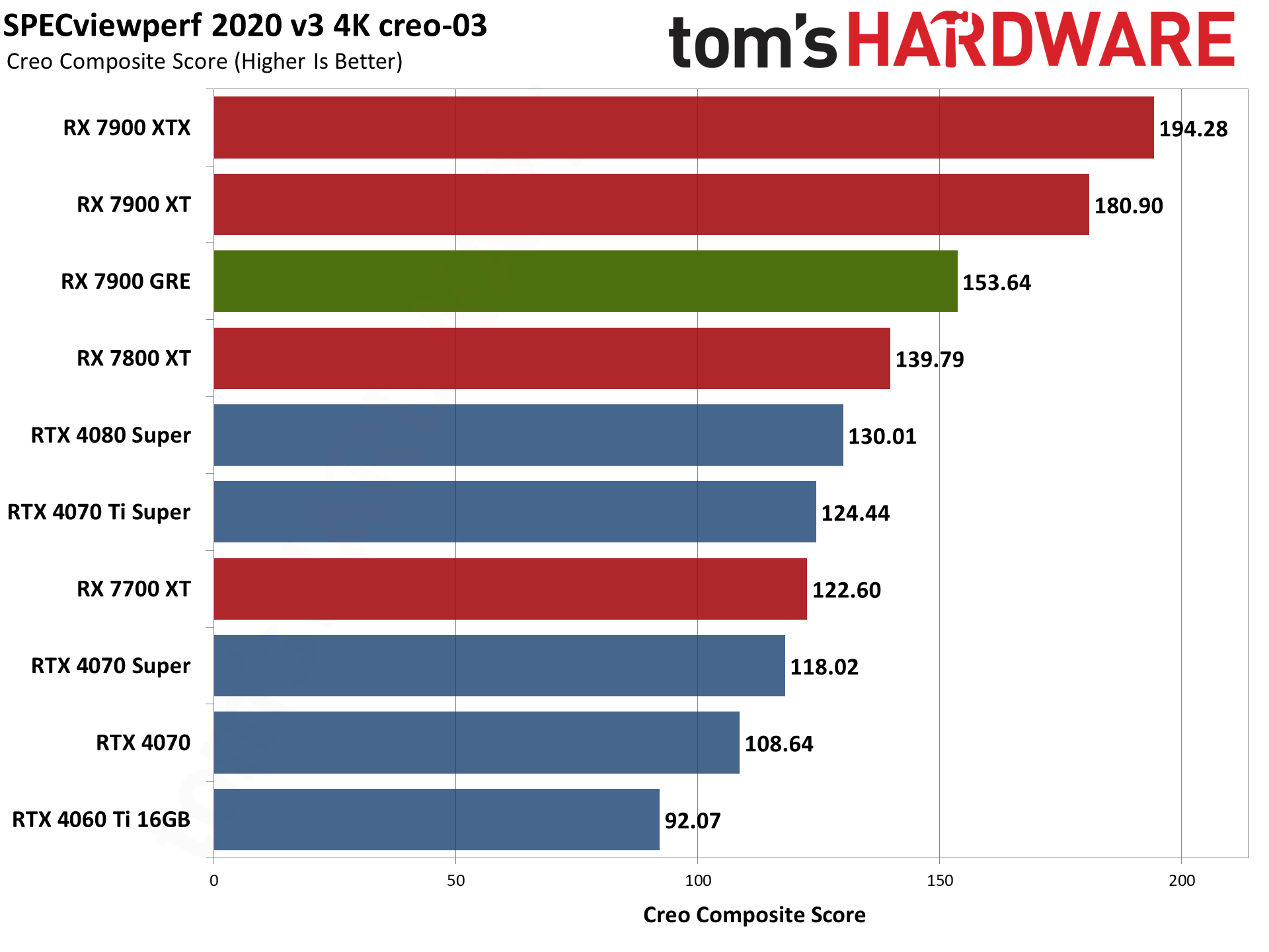
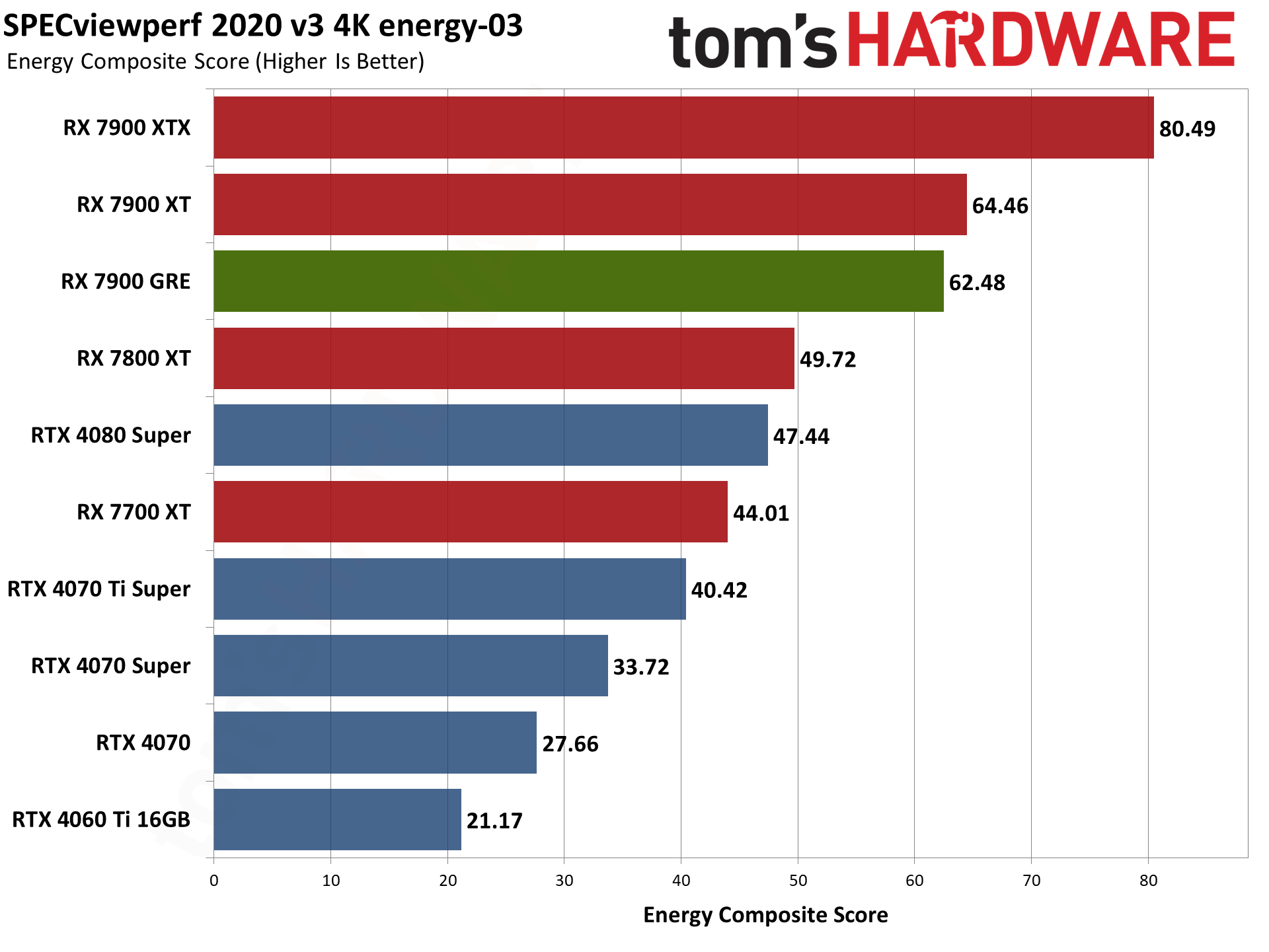
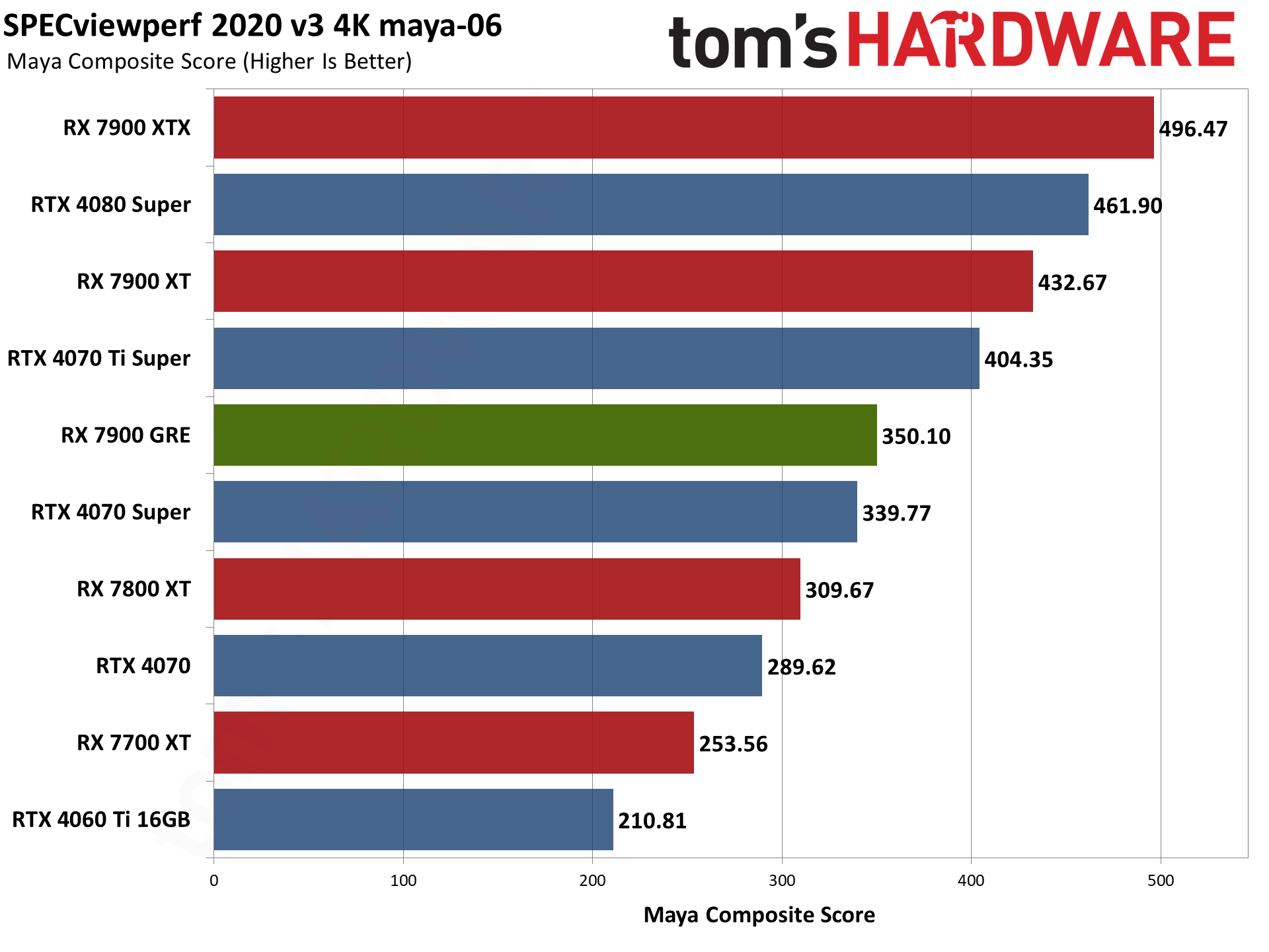
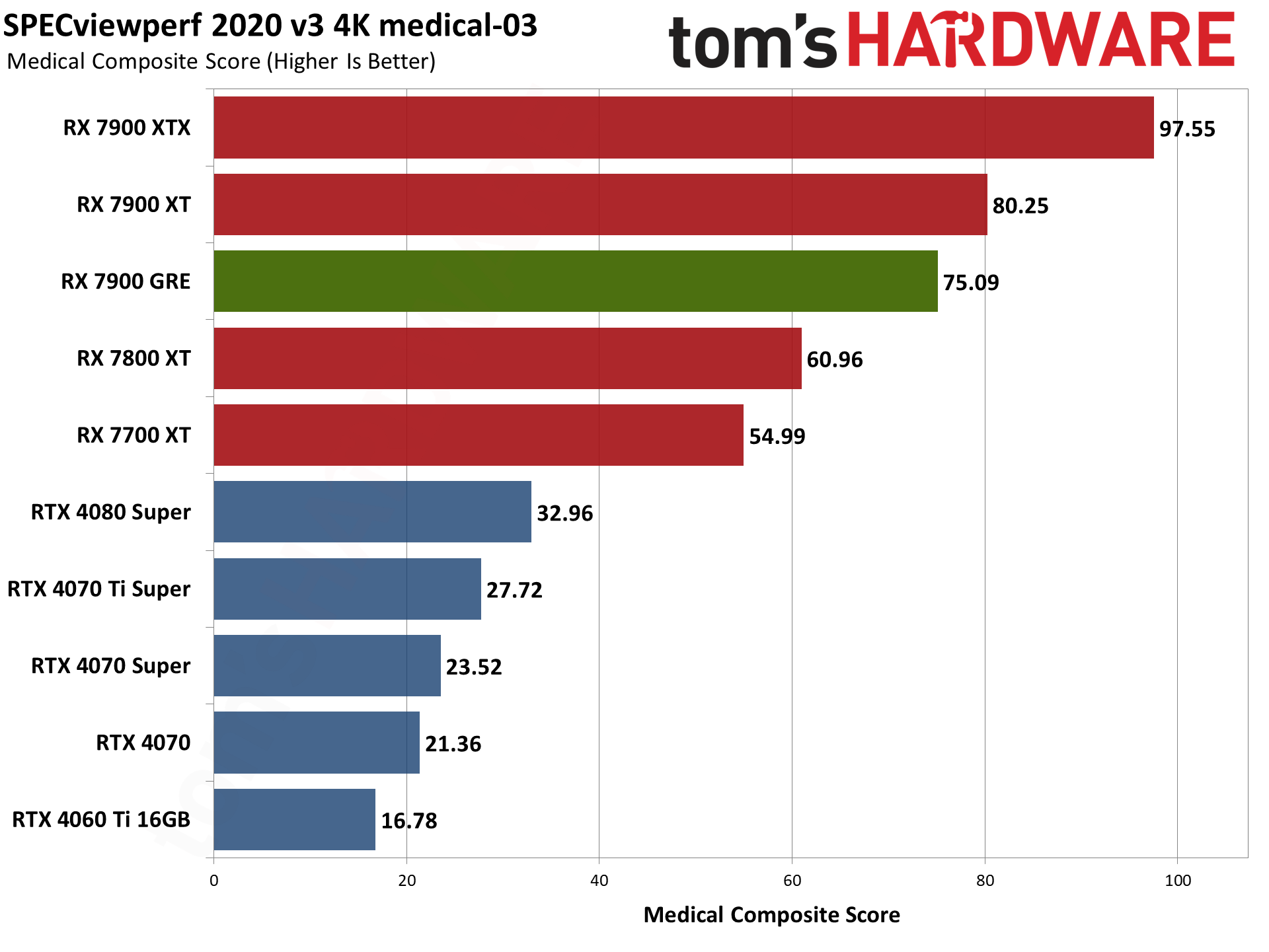
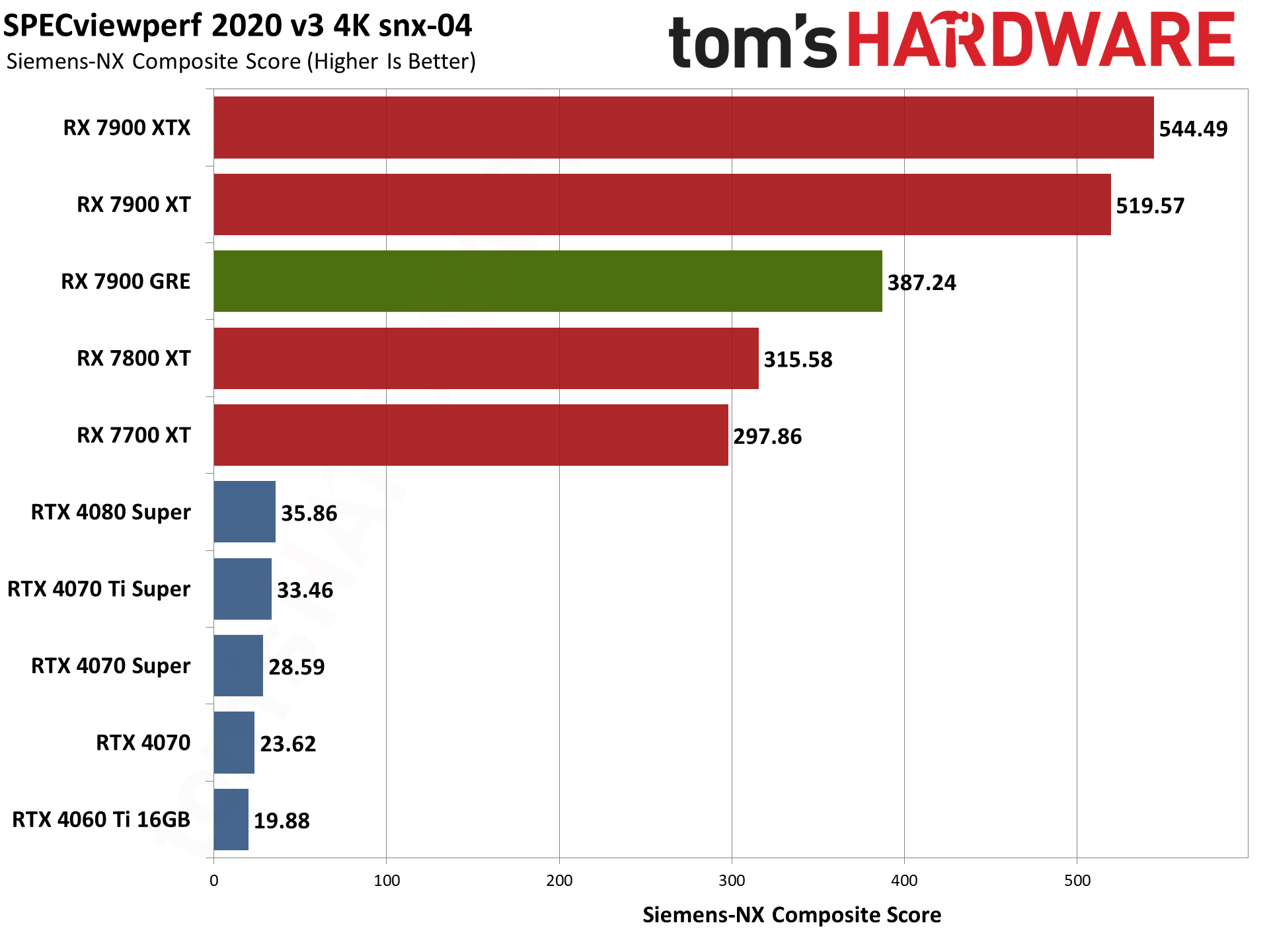
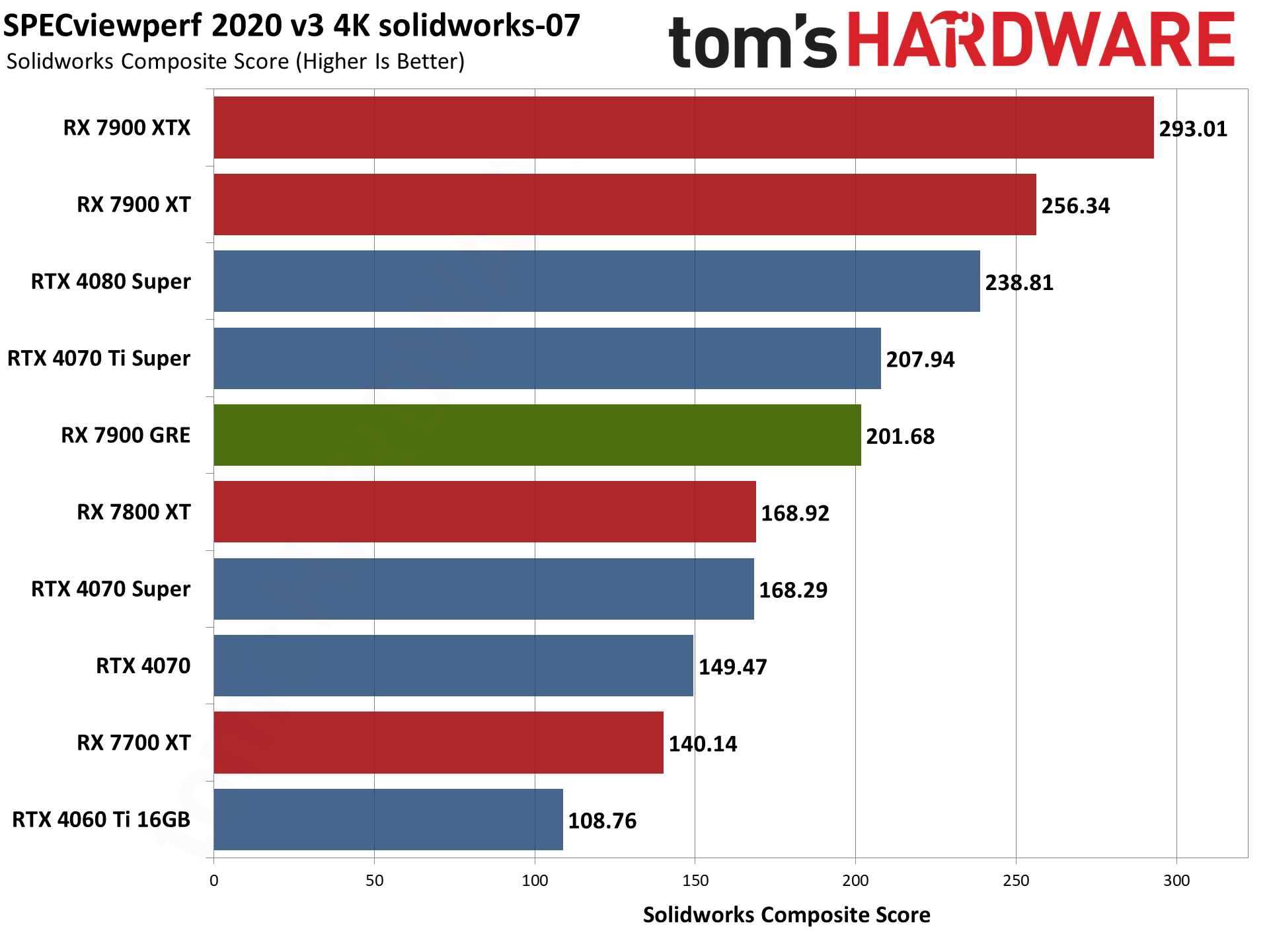
We use SPECviewperf 2020 v3 to assess professional workstation graphics performance on the various GPUs. Somewhat akin to the rasterization results — but for entirely different reasons — AMD's RX 7900 GRE does extremely well overall compared to the RTX 4070. That's because Nvidia only offers full performance tuning in its drivers for professional GPUs like the RTX 2000 Ada Generation, while AMD has decent levels of driver tuning even on its consumer cards.
Overall, the RX 7900 GRE delivers more than double the performance in SPECviewperf 2020 — it's 127% faster in our geomean. But the geomean here isn't quite as useful, as a lot of professionals may use only one or two specific applications. Even so, out of the eight individual tests, the 7900 GRE beats the RTX 4070 in every single case — it's 8% faster in 3dsmax-07, 21% faster in maya-06, 35% faster in solidworks-07, and 41% faster in creo-03. And then we get to the apps where it absolutely destroys the Nvidia card: 120% faster in catia-06, 126% faster in energy-03, 252% faster in medical-03, and 1540% faster — yes, over 16X faster! — in snx-04.
Nvidia might say that it's GeForce cards simply aren't intended to run many of these workloads, at least not at higher levels of performance, but that's by design. The underlying hardware in the GeForce and professional cards is the exact same; it's just that Nvidia has specific optimizations in the professional drivers that it doesn't enable for the consumer parts. If you want to try using a less expensive consumer card for certain professional apps, AMD GPUs are worth considering.
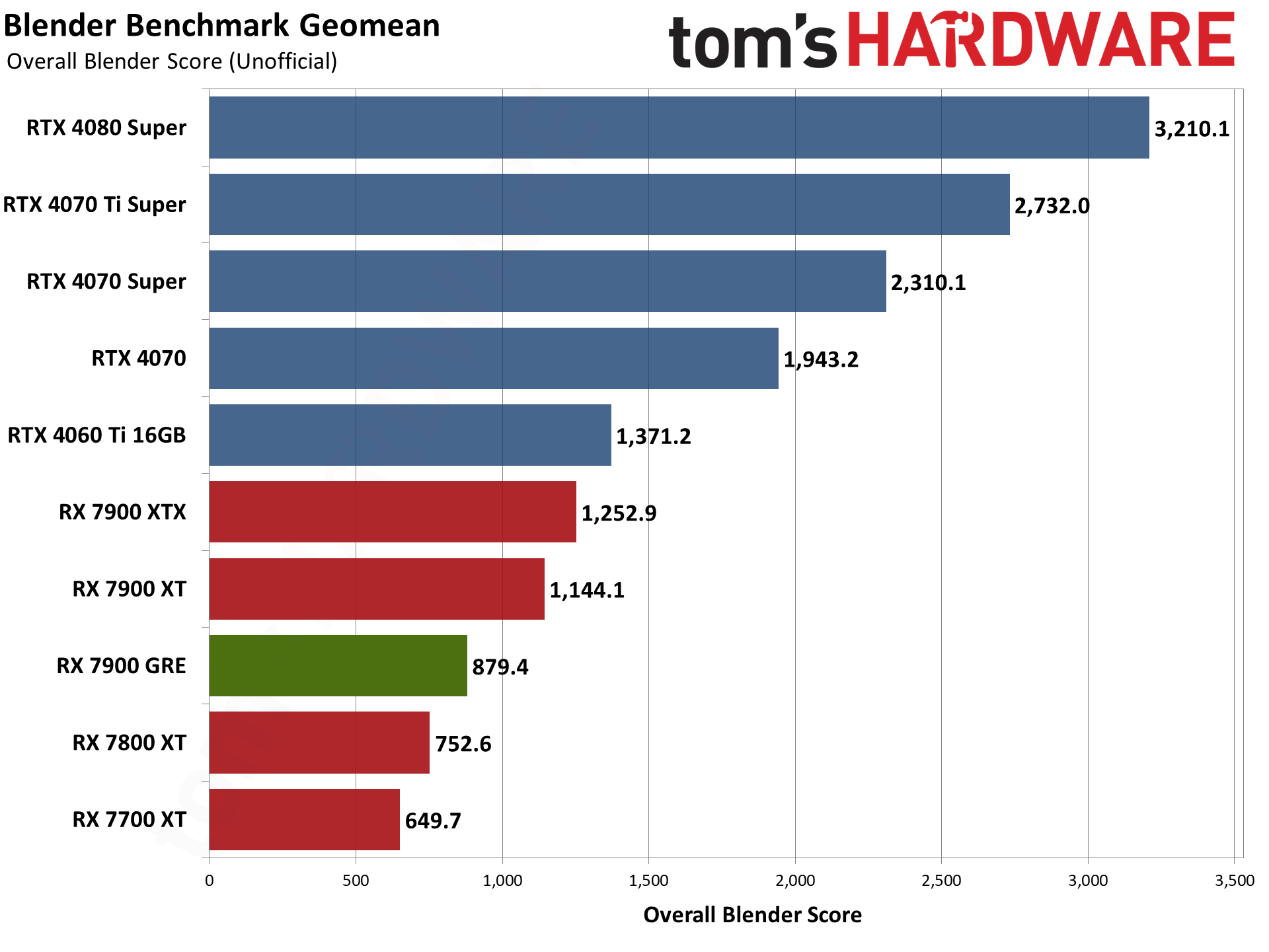
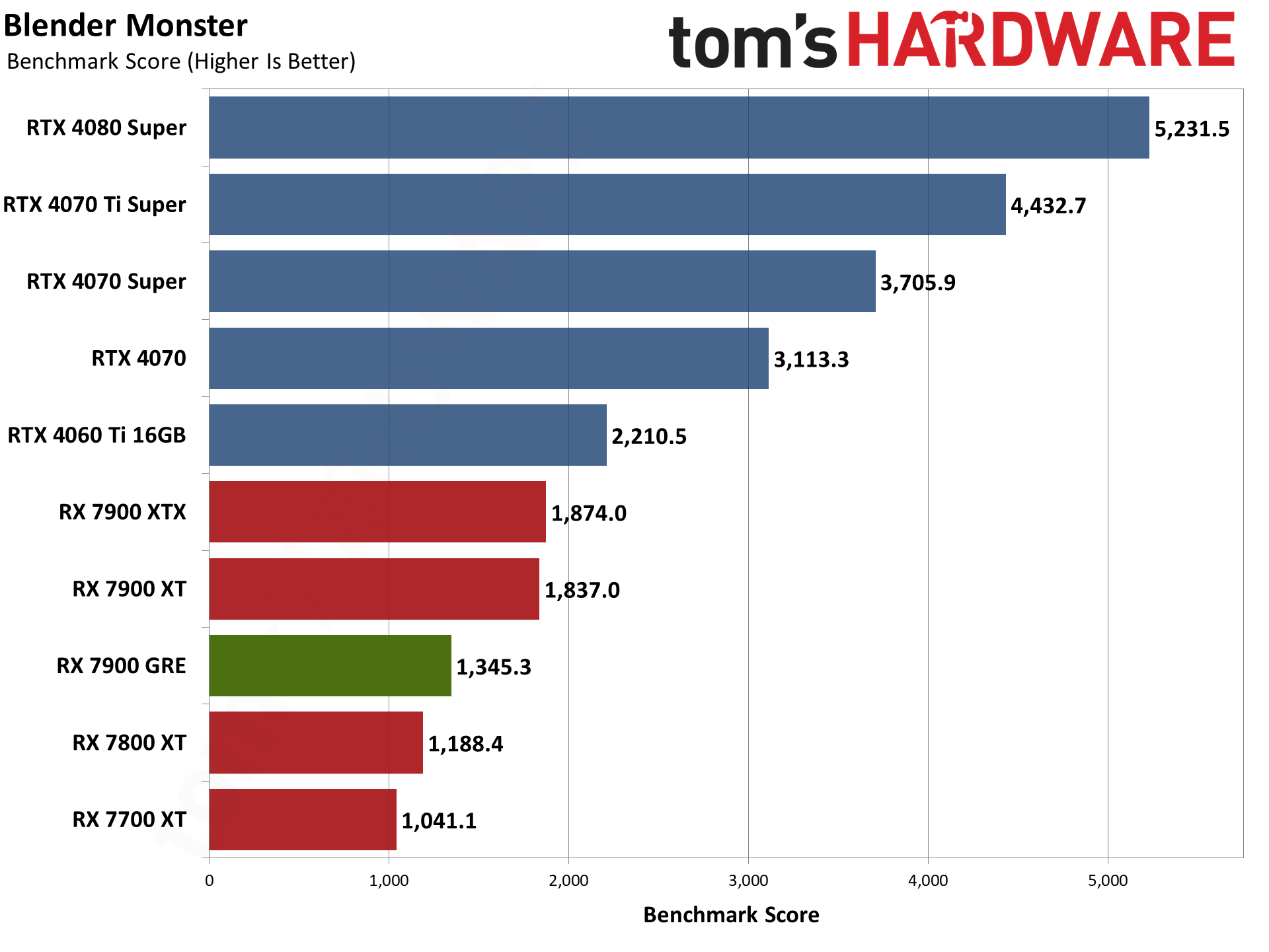
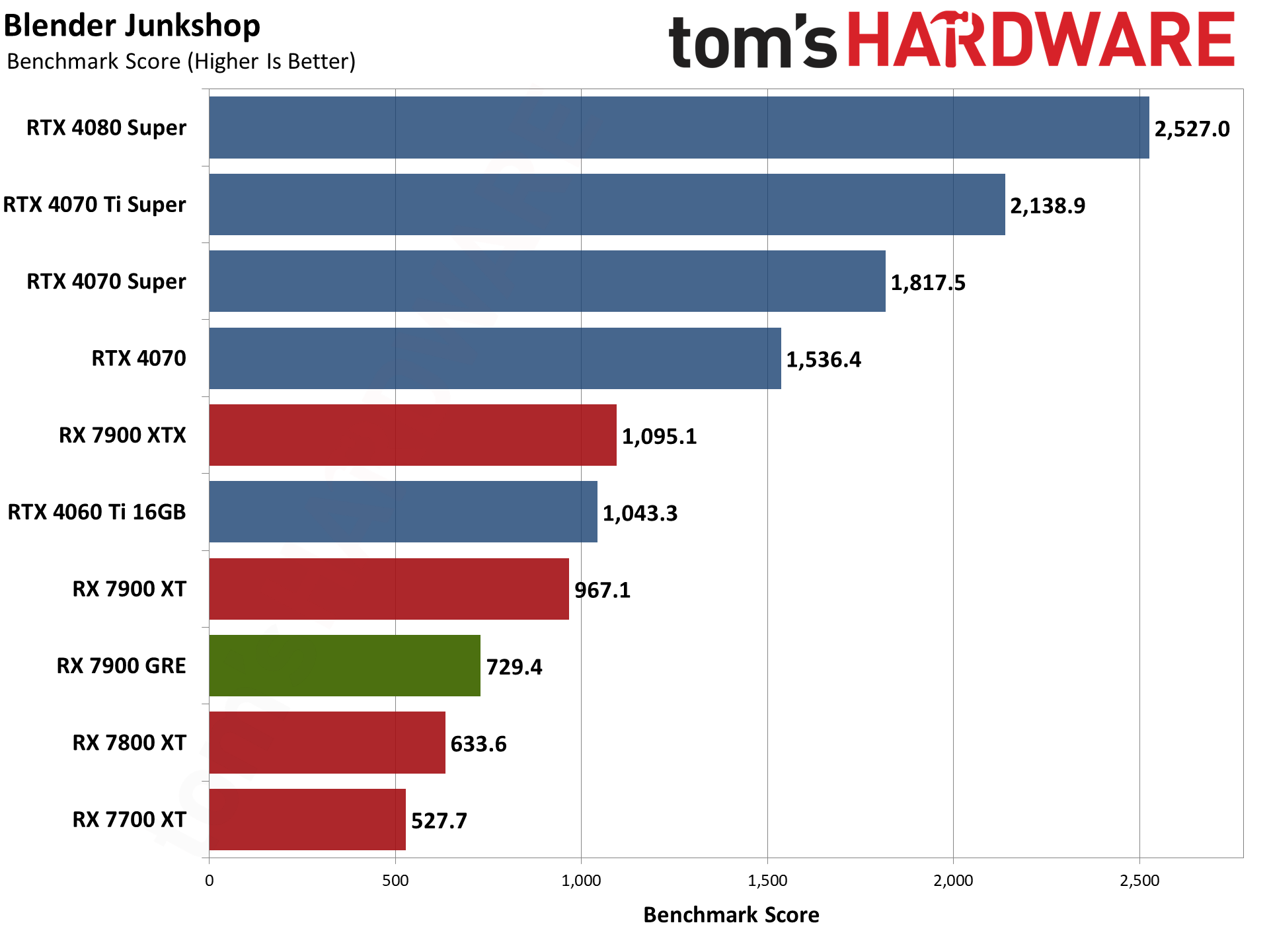
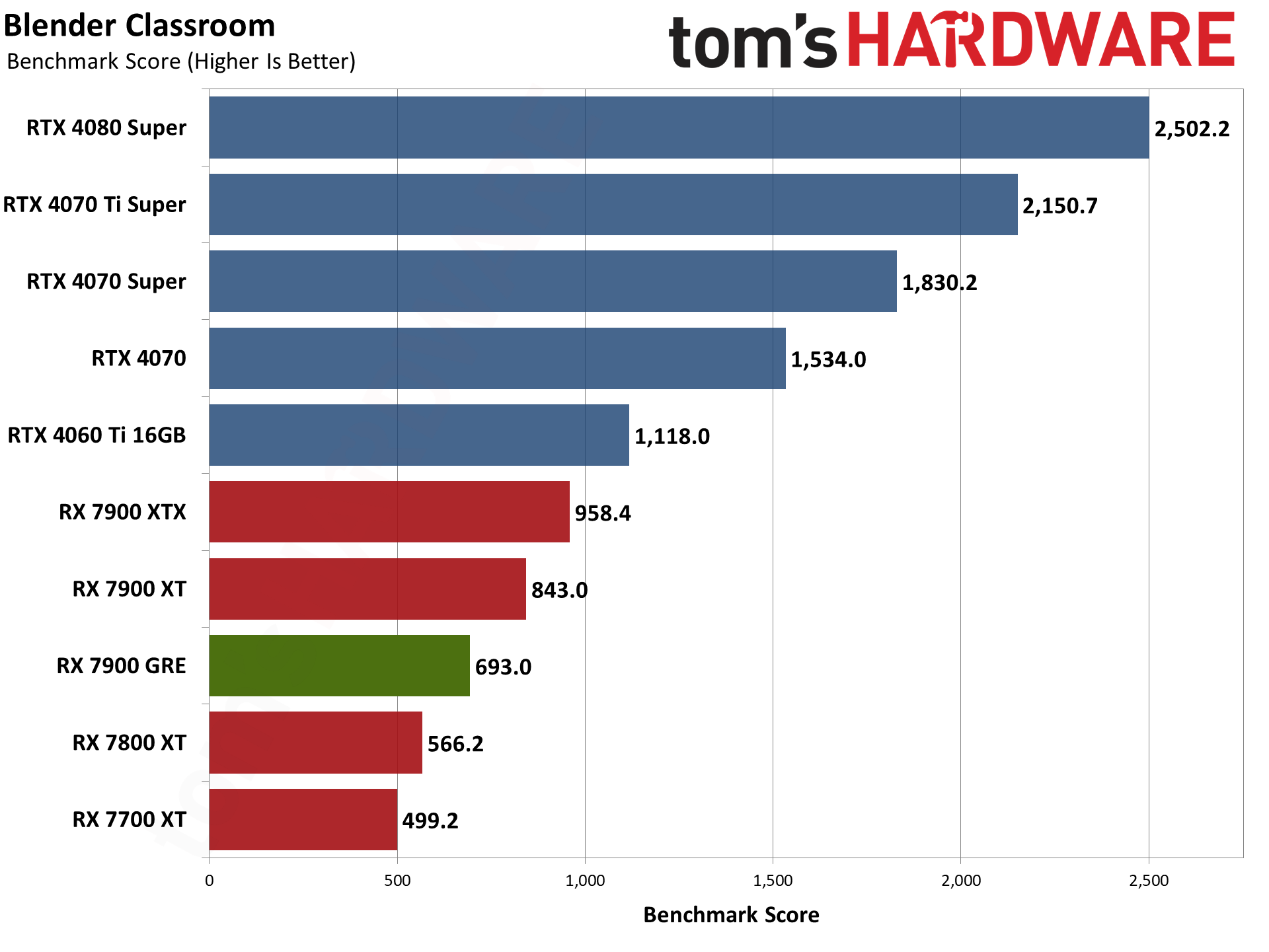
For GPU-accelerated 3D rendering, the only readily accessible app that currently supports all three GPU vendors is Blender. It now leverages ray tracing hardware to boost performance, and that puts Nvidia back in the pole position. We're using Blender Benchmark, version 3.6.0 — Blender 4.0.0 is also available, but the workloads aren't the same and we haven't yet decided to retest all of the GPUs on the latest release.
The results here are effectively the reverse of the SPECviewperf numbers. Nvidia's RTX 4070 is over twice as fast as the RX 7900 GRE in Blender, and there are other commercial 3D rendering apps that also support Nvidia hardware, like Otoy Octane and V-Ray. Given Nvidia basically pioneered modern ray tracing hardware more than two years ahead of AMD, these results shouldn't be too surprising.
AMD RX 7900 GRE Content Creation Summary
Professional workloads aren't normally the primary use case for consumer GPUs. Yes, you can run them, and some of them do just fine, but content creation professionals will usually opt for the additional support and performance offered by professional GPUs — or at least their employers will.
The RX 7900 GRE ends up delivers an interesting mix of results, particularly when compared to the RX 7800 XT. In some cases, its performance tracks closely with the theoretical compute, while in others the memory bandwidth appears to be a bigger factor. In general, though, compute is more critical for these applications and the GRE makes a great alternative to the 7800 XT, where it's up to 25% faster in some cases.
The exception to the above is in AI workloads, or at least Stable Diffusion, where performance basically matches the less expensive 7800 XT. Not that we'd recommend AMD GPUs for people primarily interested in AI, unless they specifically want to work on improving AMD support for such workloads. Nvidia currently rules the roost when it comes to consumer GPUs and AI in general.
- MORE: Best Graphics Cards
- MORE: GPU Benchmarks and Hierarchy
- MORE: All Graphics Content
Get Tom's Hardware's best news and in-depth reviews, straight to your inbox.
Current page: AMD RX 7900 GRE: Professional Content Creation and AI Performance
Prev Page AMD RX 7900 GRE: 4K Gaming Performance Next Page AMD RX 7900 GRE: Power, Clocks, Temps, and Noise
Jarred Walton is a senior editor at Tom's Hardware focusing on everything GPU. He has been working as a tech journalist since 2004, writing for AnandTech, Maximum PC, and PC Gamer. From the first S3 Virge '3D decelerators' to today's GPUs, Jarred keeps up with all the latest graphics trends and is the one to ask about game performance.
-
Notton So it falls directly between a 7800XT and 7900XT, and should have been called the 7900.Reply
It looks really good as a 1440p card.
It's not that interesting, considering it's price tag.
I'll wait to see what the RTX 5000 and RX 8000 series brings to the table, unless my 1070Ti croaks first. -
Giroro I'm surprised they didn't completely rebrand the card for the west. More generally, I'm surprised they're releasing it in the west at all.Reply
10% more performance for 10% more money isn't exciting, it's pointless. If they feel the need to release a minor stop-gap card, then I think they won't be ready to release anything truly exciting anytime soon. Maybe the AI surge has made them go back to the drawing board with RDNA 4.
It's hard to explain, but In my mind, something about calling it "Golden Rabbit" severely devalues it. So I imagine they at least will never spell out that acronym. Gold isn't valuable or aspirational; it's always cheap, fake, and tacky.
Also, I don't associate rabbits with being fast - I associate them with the weak fluffy bunnies that keep tearing up my yard.
Calling it golden means its a knockoff. It makes me think the GPU is actually some ancient Radeon HD 7970 chip that somebody is fraudulently trying to pass off as a counterfeit RX 7900 on Temu for $80 - or that it might have a virus or set my computer on fire.
Maybe I just buy too much counterfeit garbage from overseas. -
UnforcedERROR The conversation at $550 right now is almost specifically 1440p raster, which the 7900 GRE performs handily in. At these prices, 16 GB vs 12 GB for the 4070 is the biggest argument in its favor. Neither card is competent in Ray Tracing at 1440p, and the price-to-performance difference isn't enough to argue much otherwise, so it's mostly about longevity.Reply
As others said, it's not terribly interesting, and it feels like a notably late arrival, but it's something I suppose. I still feel like the $500 - $700 segment of cards is wholly disappointing from both NVidia and AMD. -
ohio_buckeye So it’s basically similar performance to a 6900xt or a 6950xt it sounds like? I’m happy with my 6800xt for now that I got under $450 new. I’ll hold onto that a while.Reply -
AgentBirdnest Hmm... I don't find it particularly exciting, but I don't have anything to complain about either. AMD had to do something to counter Nvidia's 4070 Super (and non-Super price drop), and this does it.Reply
What I'm really excited about, is where the 7800XT goes from here. I don't imagine it's going to stay at $500. If it drops to $450, that would be an extremely compelling option, and probably the best value of this generation.
As always, props to Jarred for the fabulous review! : ) -
thestryker Seems like decent enough perf/$, but doesn't really bring anything new to the table as expected. Not needing a video card has been a great place to be this generation as we're just now seeing some decent values though still limited to >$400.Reply
Per TPU the VRAM is limited to 2316mhz which caps the potential memory bandwidth at ~593 GB/s. The power limits on the card are at least standard so if anyone wants to try their hand at getting higher boost clock it is possible. -
ingtar33 this is basically just going to fill in the hole the 6900xt left in the market when it's stock ran out, they are both priced about the same, both perform about the same.Reply
It's not bad. the performance difference from the 7800xt to the 7900xt was pretty big (as was the $$ difference), this will slide right in between them at the old 6900xt price. It's a solid buy i think. I mean as solid as today's prices get.
everything is still overpriced. -
JarredWaltonGPU Reply
I do wish AMD hadn't lowered the VRAM speed from 20 Gbps. That probably would have given it another ~5% in performance, which would have been good. Right now, it's between the 7800 XT and 7900 XT, but slightly closer to the former. It makes sense from a pricing perspective, but even a few percent more overall performance would have been nice.ingtar33 said:this is basically just going to fill in the hole the 6900xt left in the market when it's stock ran out, they are both priced about the same, both perform about the same.
It's not bad. the performance difference from the 7800xt to the 7900xt was pretty big (as was the $$ difference), this will slide right in between them at the old 6900xt price. It's a solid buy i think. I mean as solid as today's prices get.
everything is still overpriced. -
Alvar "Miles" Udell Like all AMD cards for the last couple of generations, it's good, but it's just priced way too close to nVidia to be a true competitor, and this is no exception. At 2560x1440 and 3840x2160 the 4070 Super was effectively equal in terms of rasterization and superior with ray tracing, and it's only as little as $50 more expensive. How is AMD going to persuade all of the lifelong nVidia users and people like me who have had multiple negative experiences with Radeon cards to jump from Team Green over $50?Reply
And once third party custom models are included that price will exceed the 4070 Super, making the 7900 GRE a non starter. -
ohio_buckeye Reply
The good time to buy will be sales maybe around Black Friday imo. Now granted my 6800xt was last generation when I bought it this past December. On the other hand, $439 was a deal for a card that is essentially equivalent to a 7800xt.Alvar Miles Udell said:Like all AMD cards for the last couple of generations, it's good, but it's just priced way too close to nVidia to be a true competitor, and this is no exception. At 2560x1440 and 3840x2160 the 4070 Super was effectively equal in terms of rasterization and superior with ray tracing, and it's only as little as $50 more expensive. How is AMD going to persuade all of the lifelong nVidia users and people like me who have had multiple negative experiences with Radeon cards to jump from Team Green over $50?
And once third party custom models are included that price will exceed the 4070 Super, making the 7900 GRE a non starter.
As someone above said if they’d put the 7800xt at $450, or even $475 then it goes on sale, that would be a decent price to performance imo.
